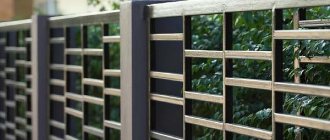A fence that stands between two areas can cause conflict between neighbors. There may be disagreements regarding its height and type of material. Which neighbor should choose the fencing material and who should pay for the work associated with its installation? Is your neighbor required to cover part of the cost if you have already installed the fence yourself? All this will be discussed further in the article.
The material was prepared by our editors together with the lawyers of the Family Legal portal.
Who owns the fence between neighbors?
In order to find out who the owner is, it is necessary to find all evidence of payment (checks, receipts, installation agreements). You can also take into account the testimony of eyewitnesses (installers or other neighbors).
Next, after studying the site plan, you should find out on whose land the fence is located. He will be the owner.
So, the owner of the fence can be:
- Owner of land (plot). In this case, he is responsible for repairing the fence.
- His neighbor. He is responsible for the safety of the fence.
- Both. If the fence is located on the border of two plots, we can talk about common property. Accordingly, all repair work must be resolved by agreement of the two parties.
Important! Only the totality of all documents will help determine who owns the fence. The best option is to install it on the border of the plots of two neighbors. In this case, both parties have equal rights and obligations in relation to the fence.
What is a fence and where should it be located?
One of the characteristics of a land plot is its boundaries, that is, the limits where it ends and the land of other owners begins.
But they are not always defined properly. Many plots have been issued for a long time and there may be no information about their exact location. It is also possible that according to documents, areas are demarcated, but in fact, fences or other landmarks are not installed.
A fence is one of the options for defining boundaries on the ground. Also, other landmarks can be used on the ground, from some natural or landscape objects to pegs and pillars. The fence is convenient in that it defines the exact boundary and also serves as some obstacle to the entry of unauthorized persons into the territory.
The fence should be located where the property line ends. Otherwise, its position will violate the rights of the owners of neighboring plots.
Which neighbor should install the fence?
There is no clear definition in the legislation and SNiP standards as to which of the owners should install the fence. The law defines only the border between two land plots (interface), which serves as a guideline for delimiting property. As for installing a fence, this issue is resolved mutually between neighbors.
Therefore, if you want to make it your property, you need to install a fence only on your site. In this case, the owner of the fence is free to independently choose its height, type of material, design features and color. Accordingly, all material costs also fall on the owner.
If both neighbors are interested in common property, they jointly resolve issues related to the characteristics, installation of future fencing, and also distribute all costs among themselves.
Lawyer's opinion: Before installing a fence, talk to your neighbors. Often in cottage villages there are certain rules that assign ownership of the fence, for example, to the area on the left. Of course, such traditions do not have legal force, however, by observing them, you will be able to initially build good relations with your neighbors.
We are building a fence on a garden plot - standards for building a fence
Special laws and SNiPs contain regulations for the garden plot. And if laws are mandatory, then SNiP is a recommendation.
In accordance with building codes and regulations
the fence on the garden plot should be located at a certain distance relative to the following objects:
There are legislative standards regulating the construction on the territory of non-profit associations of horticultural (dacha) type. Before starting construction of a fence, the owner of a garden plot must take into account the approved development standards. According to their requirements, the main points are as follows
:
- the construction of buildings in a gardening association is permitted only according to a specific territory development project;
- compliance with requirements during the construction of objects is monitored by the board of the association together with inspectors of government agencies;
- materials used in the construction of structures and infrastructure are determined by the members of the horticultural association independently, in accordance with the organization and development project;
- if buildings and structures erected on plots exceed the parameters determined by the project of a horticultural non-profit association for these structures, it is necessary to approve the changes (this issue is dealt with by self-government bodies).
Who should pay for the installation?
The legislation does not determine which neighbors are required to pay the costs of installing a common fence.
In this situation, there are several possible solutions to the issue:
- Both neighbors share equally in the cost of installing the fence. Issues related to various characteristics of the fence are also resolved mutually.
- The owner of the plot bears the cost of fencing the side that borders the neighbor on the left (or right). Other neighbors follow the same rule. With this option, you should be sure to inform all your neighbors about your desire in order to avoid possible misunderstandings in the future.
- The owner of the property installs the fence entirely at his own expense, and then negotiates with the neighbor to reimburse part of the costs. It should be noted that it is legally impossible to oblige a neighbor to pay. In this situation, the issue is resolved only on the basis of good relations between neighbors.
- A neighbor installs a fence at his own expense, violating the boundaries of your property. In this case, you have the right to go to court, which, however, cannot guarantee a positive decision, since the court, as a rule, takes into account a large number of factors.
So, if you decide to install a new fence, you should first discuss your plans with your neighbors to avoid conflicts and misunderstandings. If they don't want to split the cost, you're free to do the installation yourself.
To protect yourself, you should:
- Get a receipt from your neighbor stating that he has no complaints about the appearance of the fence or its installation. This document will help if suddenly after a while a neighbor decides to take you to court over the illegal installation of a fence.
- Obtain written permission for installation from the head of the village. It will be needed when a neighbor is categorically against installing a fence and prevents it in various ways.
Important! If you have not yet surveyed your site, you should definitely do so. It is knowledge of clear boundaries that will allow you to correctly determine the location of the future fence. This will avoid dissatisfaction with neighbors and their going to court. After all, if your neighbor turns out to be right and you have violated his boundaries, you will have to dismantle the fence at your own expense and move it to another place.










